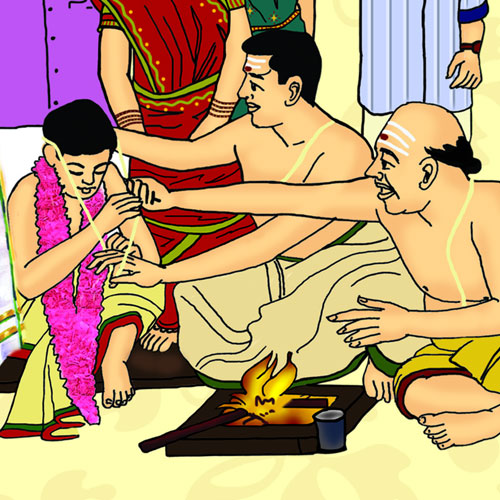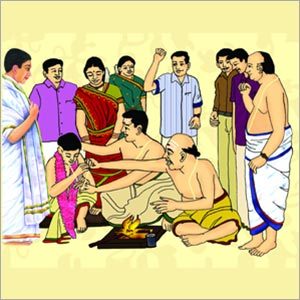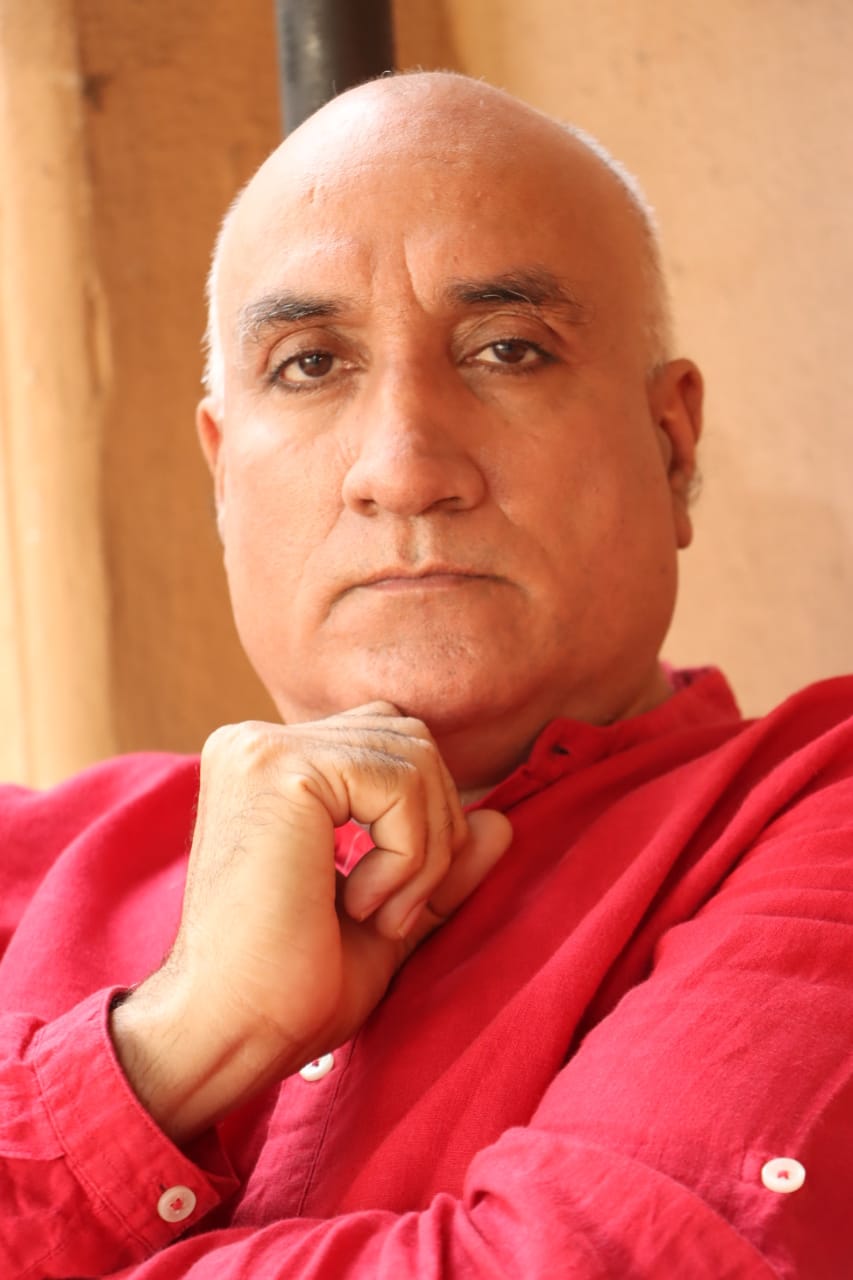
Upanayana Sanskar

Upanayana Sanskar has a special importance among the Anuvrata Sanskars. The basic foundation of the entire Shrautasmart rituals is this Upanayana Sanskar. Therefore, it is necessary to give special thought regarding this. Without this sanskar, the Dwijatva of a Dwijati (Dwijnama – Double Born) remains completely incomplete. Due to the influence of this culture, the Dwijati class is blessed with verses like Gayatri etc. It is through this sanskar that the Dwijati people get the rights of Yagya. This is the starting point of the first ashram named 'Brahmacharyashram'. There are many names of this Sanskar like “Upanayan-Yajnopavit-Acharyakaran” etc. After being initiated in this sanskar, the child is taken to the Gurukul to study the Vedas etc. with the Acharya, hence it is called 'Upanayan' sanskar. The act by which one is brought up (to the Guru for the study of the Vedas), is called Upanayana.
Through this ritual, 'Yagya Sutra' is put around the neck of the Dwijati. This Yagya Sutra is famous by the name "Yajnopaveet/Yagyopaveet". Since through this Sanskar, the human being (child) is made Yagyopaveeti and imbued with the Yagya Sutra, hence it is also practiced by the name “Yagyopavit Sanskar”. The Upavit of Yajna itself is Yajnopavit.
Yajnopavita draws our attention towards these three institutions: spiritual yagya, spiritual yagya and primal physical yagya. Therefore, before knowing the basic form of Yagyopaveet, it is very important to know the meaning of the word 'Yagya' and also to know what is the relation of Yagya Sutra with nature.
In Vedic science, the mutual relationship between any two things has been explained in two ways. The first simple relationship is Antaryam relationship which is called 'Yaga'. For example, the relationship between clothes and the body can be understood as 'Yoga' relationship and the relationship between food eaten with the body's fire can be understood as 'Yaga' relationship. In other words, the chemical combination of two heterogeneous substances is called 'Yaga' relationship. This 'Yag' relationship is called 'Yagya'. Every substance of the universe is the result of the Yagya process, is established on the Yagya and ultimately those substances get dissolved in the immersion process of the Yagya.
The sages have considered all the constituent elements of Yagya to be the essence of these two things, Agni and Soma. According to the Vedic definition, fire is a 'Combusting' element and Soma is a 'Combustible' element. The coordination of these Agni-Soma is called 'Yagya'.
It is due to the mutual coordination of Agni-Soma that the six seasons of Agni-Soma develop. The coordinated form of these 6 seasons is called Samvatsar Yagya.
Uttarayan, Dakshinayan and Equinox are the three main festivals of Samvatsarak Yagya Purusha. These three festivals of Samvatsara are the originators of creations called Deities, Ancestors and Humans respectively. These three festivals are governed by the Sun.
The Moon has a daily relationship with the Sun and the fixed path on which the Earth revolves around the Sun keeping the Sun at the center is called 'evolution'. This circle has been considered to have 48 degrees. In this, the seven verses of Gayatri etc. are revered. This revolution is the metrical formula by which the Yagya Purusha of the Samvatsara remains dignified. Therefore, this formula in the form of revolution is also called Yagya-Sutra. Within the same Kranti-circular Yagya-Sutra, three Avantar festivals have been mentioned with the distinction of Uttarayan, Dakshinayan and Vishuvad. These three festivals are the three successive sutras of the Yagya Sutra respectively. It is only by the combination of these three Avantara Sutras that the form of Mahayajna Sutra is formed.
In Natural Yajna-Purush, the relationship of Uttarayana with gods, Dakshinayana with ancestors and Equinox with humans has been described. The equator itself forms the spinal cord of our body. Due to this, the southern part is south-round and the northern part is north-round. The spinal cord itself is equatorial. The coverage of the Sun is up to 24 degrees. That is, 24 degrees south and 24 degrees north is the ultimate revolution. This spirit of revolution is the substance of our ribs. Because the ultimate meaning of revolution ends at 24 degrees only. Therefore, there are only 24 ribs in our body. After reaching the ultimate revolution, the speed of the earth becomes infinite. That is why, similar to this movement, our ribs also get bent instead of going straight. The Sun is in Dakshinayan in North Gola and Uttarayan in South Gola. The state in which the Yajna Sutra remains on our body is related to Uttarayan. This is divine feeling.
In Pitru Karma, Yagya Sutra is placed on the right shoulder, this indicates the Dakshinayan period. What is meant to say is that in order to inform about the arrival of the Sun in the Dakshinayan period, the sages have ordered to put the Yagya Sutra on the right shoulder. This is also indicative of paternalism. Keeping Malavat Yagyasutra (Janeyu) around the neck is a human gesture.
Moon also has a close relationship with Solar Samvatsara Yagya. The lunar rotation circle of the Moon is known as 'Dakshvritta'. It is also called 'Chandrarath'. This Chandraratha is considered to have three wheels. What is meant to say is that during the rotation of the Yagya Sutra Nakshatra-Grahavachchin Samvatsara Mandal by the Moon, known as Nakshatra-Bhokta 'Udupati', three routes have been imagined in continuation of the prestigious Nakshatra routes in the Yagya Sutra Samvatsara-Yagya, which are respectively called 'Airavat'. It is called the path of 'Jaradgav and Vaishwanar'. Just as Yagya Sutra is Triparva according to the order of 'Uttarayan-Dakshinayan-Vishuvad', in the same way Yagya Sutra is considered to be Triparva according to the above mentioned sidereal path trinity.
Yagya Sutra (Janeyu) is revolutionary, the main three sutras of this Yagya Sutra are indicative of Uttarayan, Dakshinayan and Parvo. The three sutras present in each sutra (three main sutras) are indicative of lunar equinox, i.e. Dev, Pitra, Manushva Bhava i.e. Airavat Marg, Jardav Marg, Vaishwanar Marg, 9 Veethis (lanes). Again, the three other threads residing in these three sutras represent the 27 constellations like Ashvinya. In this way our Yagya Sutra (Janeyu) actually becomes the image of the divine world.
This was an external discussion. Now consider that Yagya Sutra, in order to introduce the form of which the form of solar-moon chariots had to be explained. Yagya Sutra is made into a 96 finger long sutra based on the measurement of one's finger. The sutra is wrapped 96 times with the joined fingers of the sacred hand. That formula is further tripled. After washing with water, reciting Gayatri Mantra, force is applied from the right side while doing triguna from the left side. These triplicate fibers are triplicated again. Brahmagranthi is attached by making a Brahmapaash of the left and right ends. The hairs that come out while making the sutra are cleaned and then the sutra is completely ready. In Yajnopavita there are the five properties: Yagyopavita, Avantara 3 sutras, Avantaratar 9 sutras, Avantaram 27 sutras, magnitude of 96 anguls.
Yajnopavita itself is a sutra. As mentioned earlier, you see three threads separately in it. There are 3 more sutras in each sutra. Thus go the 9 sutras. In these subsequent 9 sutras (each), there are 3 more sutras each, which you can reveal by analyzing the sutras.
The main reason for which this Yajnopavit Sanskar is performed is that the state in which we always keep the Yajnopavit is our Yajnopavitta Sanskar. Yajnopavita is the eternal symbol of the divine creation Yagya of Samvatsara-Prajapit, which has been active since eternal time. Certainly, by accepting it as per the method, as per the rituals, as per the mantra, it becomes the founder of the distinguished Dwija-Viriya in the practice of knowledge of the transparent secrets of creation and life.
The main objective of this sanskar is the transfusion of Sarvajagaddhishthatri, Jaganmata Savitri. Until it is established in the outer part of the Dwijati , the Dwijati neither gets the right to study the Vedas nor to perform natural Vedic based Yagya etc. That is why this sanskar is considered to have special importance for the Dwijati.
The Yajnopavit Sanskar of a Brahmin is considered prescribed in the eighth year. In a person born in a Kshatriya clan the Yajnopavit Sanskar is prescribed in the 11th year. In a person born in Vaishya clan the Yajnopaveet Sanskar is prescribed in the 12th year.








